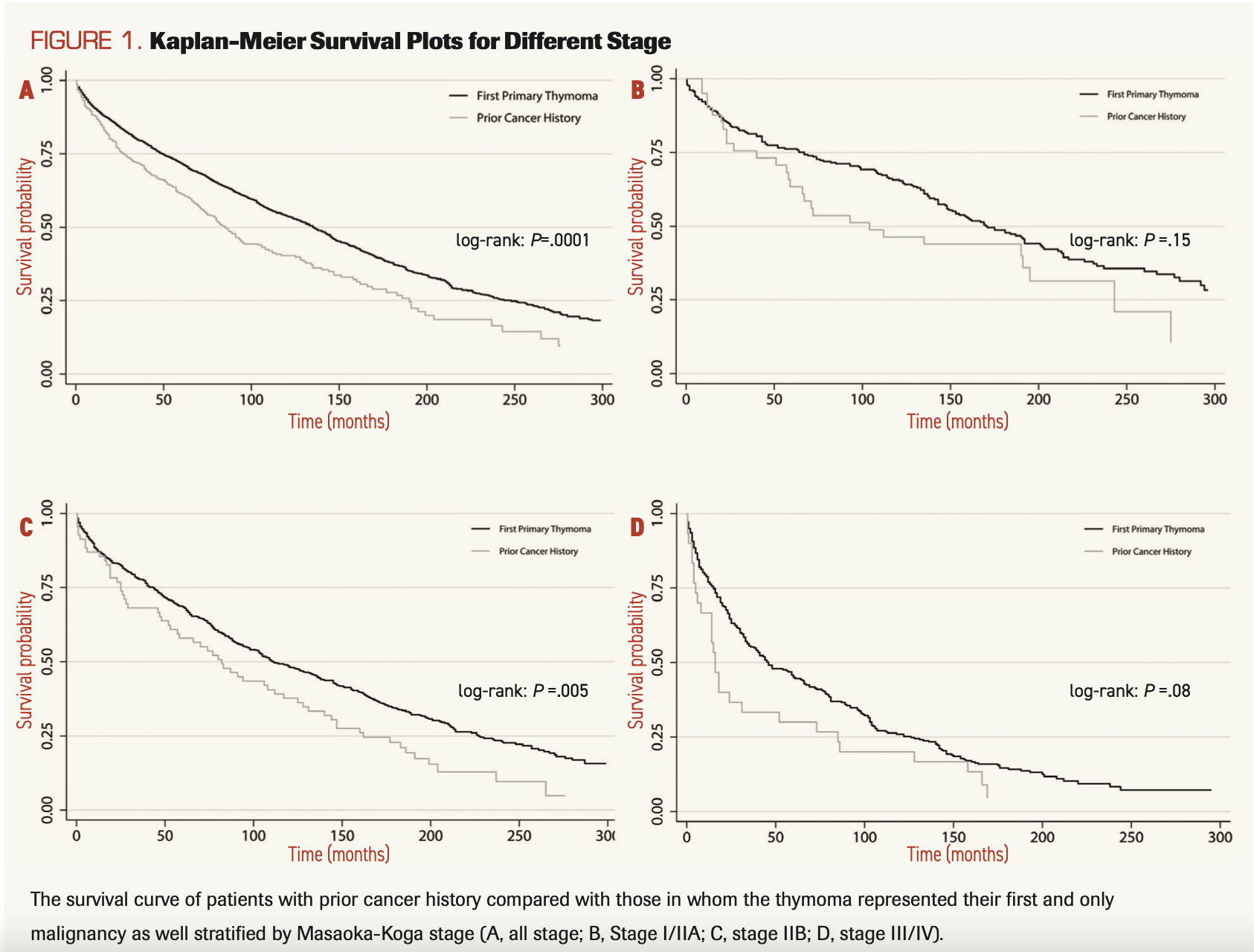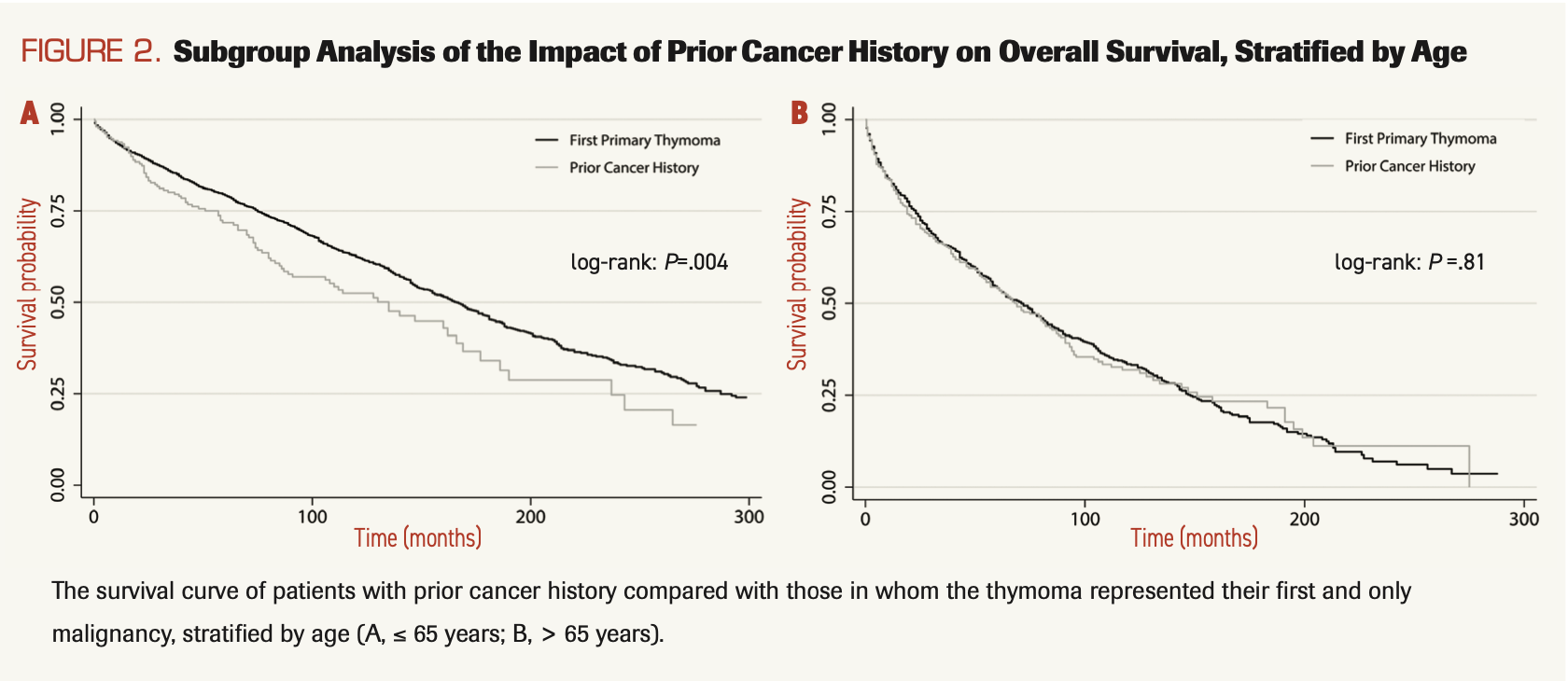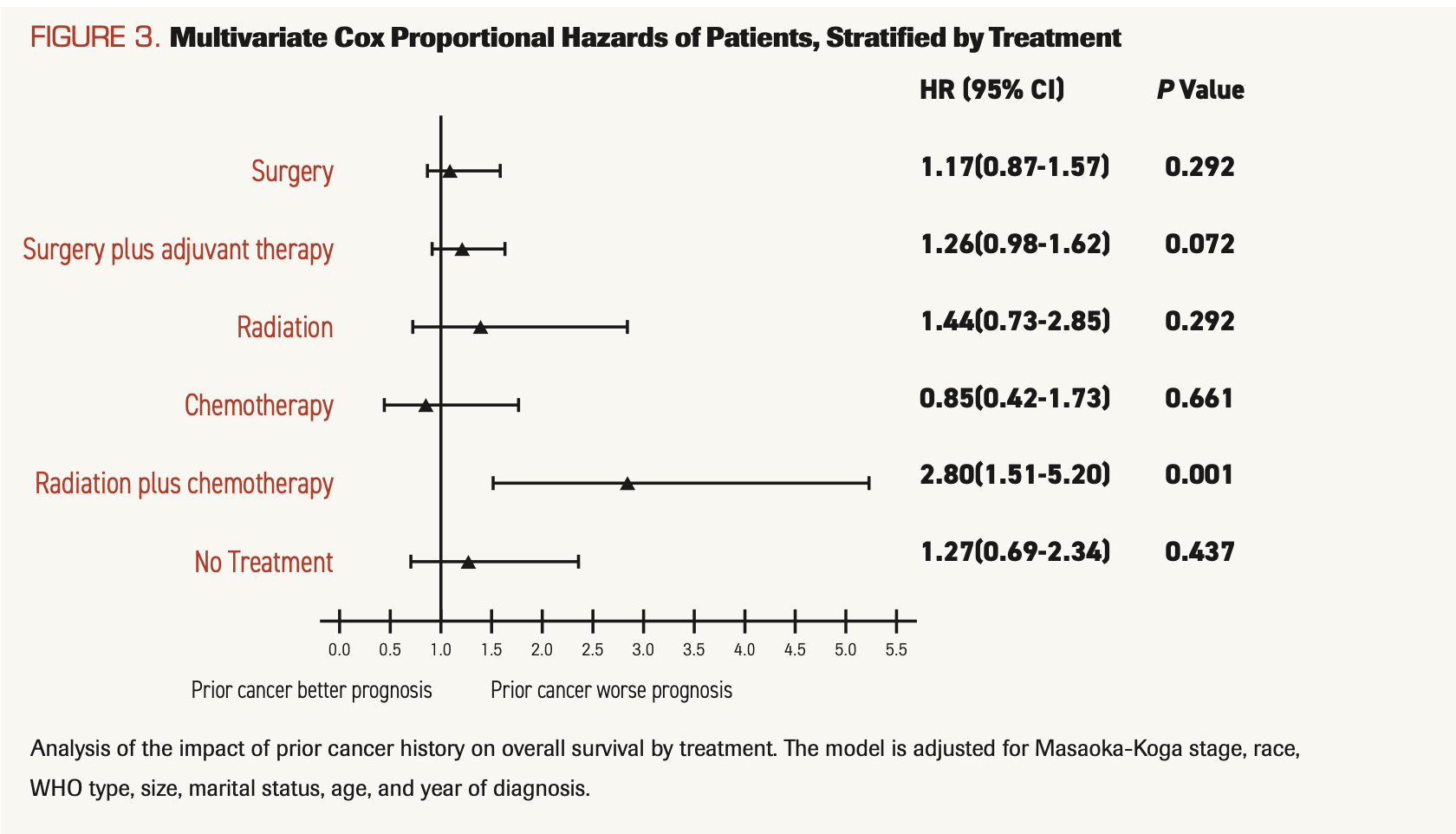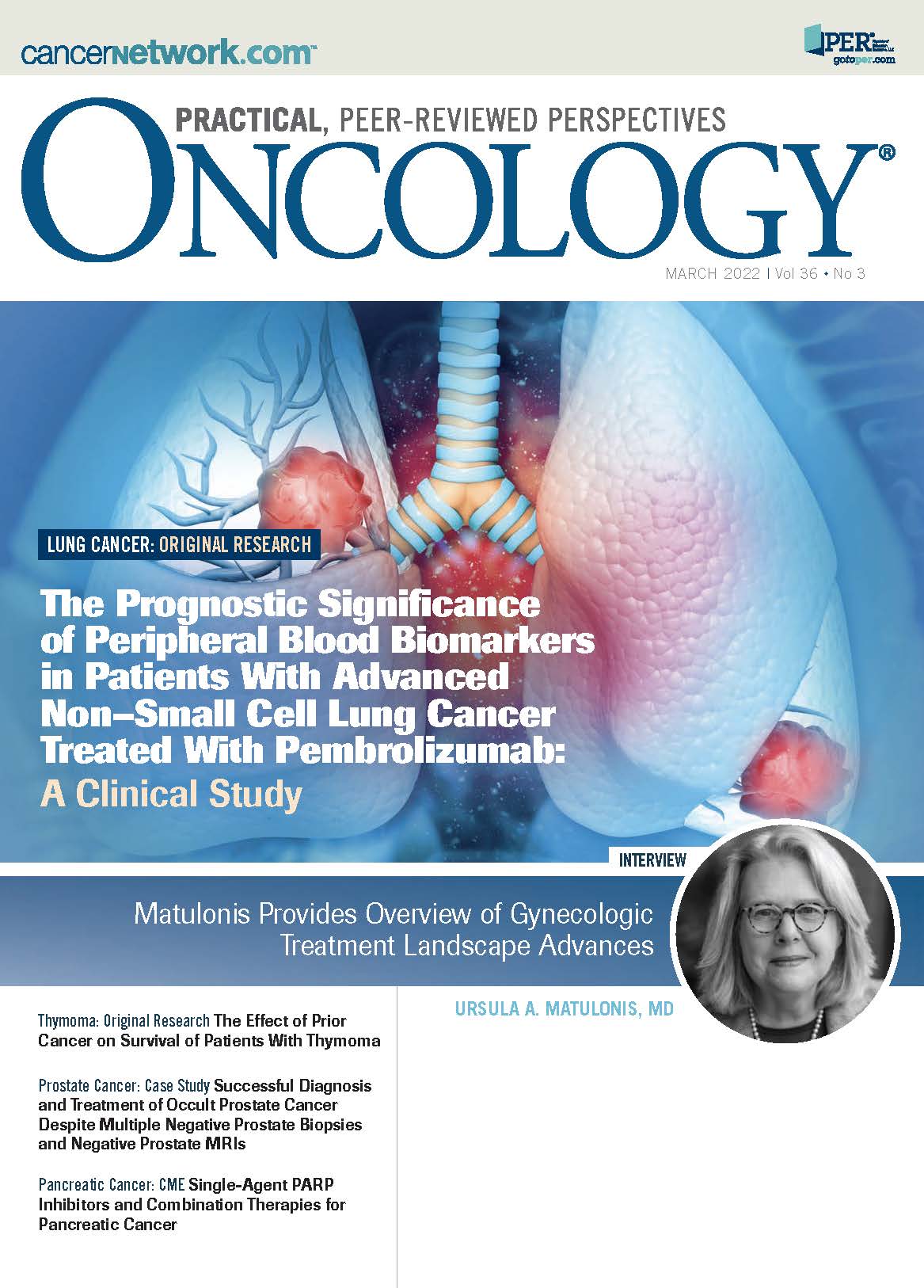The Effect of Prior Cancer on Survival of Patients With Thymoma
Shilong Wu, MD, and co-authors discuss how patients with thymoma are affected by prior cancer history.
ABSTRACT
Background: Thymoma is an uncommon intrathoracic malignant tumor and has a long natural history, with overall survival (OS) in these patients lasting decades. It is uncertain whether the survival of a patient with thymoma is affected by their prior cancer history (PCH). Finding out the impact of PCH on thymoma survival has important implications for both decision-making and research.
Methods: The Surveillance, Epidemiology, and End Results database was queried for patients with thymoma diagnosed between 1975 and 2015. Kaplan-Meier methods and the Cox proportional hazards model were used to analyze OS across a variety of stages, ages, and treatment methods, in patients both with and without PCH.
Results: A total of 3604 patients with thymoma were identified, including 507 (14.1%) with a PCH. The 10-year survival rate of patients with a PCH (53.8%) was worse than that of those without a PCH (40.32%; 95% CI, 35.24%-45.33%; P < .0001). However, adjusted analyses showed that the impact of a PCH was heterogenous across ages and treatment methods. In subset analyses, PCH was associated with worse survival among patients who were treated with chemoradiotherapy (HR, 2.80; 95% CI, 1.51-5.20; P = .001) and among those who were ≤ 65 years (HR, 1.33; 95% CI, 1.02-1.73; P = .036).
Conclusions: PCH provides an inferior OS for patients with thymoma. However, it does not worsen the survival in some subgroups, and these patients with thymoma may be eligible for study.
Keywords: prior cancer history, thymoma, survival, SEER database, clinical trial.
Oncology (Williston Park). 2022;36(3):172-177.
DOI: 10.46883/25920953
Background
Thymoma is a rare tumor deriving from the epithelial cells of the thymus, although it is the most common primary tumor in the anterior mediastinum. The prevalence of thymoma has been reported as 0.13 per 100,000 person-years in the United States.1 Unlike most other cancers, thymoma has a long natural history and the overall survival (OS) of patients with thymoma can regularly be measured in decades.2 Nonetheless, patients with thymoma with multiple primary cancers are still worthy of study. Some studies have found that patients with thymoma had a broadly increased risk for future cancers; certain patients even experience worse survival.3-5 Still, the full impact of prior malignancy on thymoma outcomes remains unknown.
Clinical trials play a pivotal role in improving the survival of patients with cancer. However, cancer history is a commonly used exclusion criterion in oncology clinical trials, due to concerns that previous treatment and survival impact could interfere with clinical results. Still, the exclusion of patients with a personal cancer history may be problematic, because it is common for clinical trials to struggle to recruit enough patients with thymoma.6 What’s more, no data exist to clearly support the hypothesis that prior cancer history (PCH) impacts the survival of patients with thymoma. Further, it is uncertain whether the results of clinical trials that excluded patients with PCH could then apply equally to patients with such history. Therefore, determining the impact of PCH on thymoma survival is important for both patients and the oncology community.
Until recently, no study has specifically evaluated the impact of PCH on thymoma outcomes, and we know little about the features of patients with thymoma with PCH. In this study, we aimed to identify the relationship between cancer history—in patients with thymoma who had such history—and the prognosis for their thymoma. Mortality risk of thymoma, as it related to a patient’s PCH, was evaluated using a cohort of patients with thymoma in the Surveillance, Epidemiology, and End Results (SEER) database.
Methods
Data Source and Study Population
All data were extracted from the SEER database through SEER*Stat Software version 8.3.6. We searched all records of patients diagnosed with thymoma between 1975 and 2015. A diagnosis of any thymoma, excluding thymic carcinoma, was identified by histology and primary site (tumor site code). The SEER sequence number variable represented the order of reportable tumors diagnosed in a lifetime and was used to determine the prevalence of prior cancer.
The patients with thymoma were divided into 2 cohorts based on whether or not they had a PCH. The PCH cohort included patients who had a cancer diagnosis before the thymoma diagnosis, and the first primary (FP) cohort included those patients for whom thymoma represented their first and only malignancy. All patients must have been diagnosed with microscopic confirmation by cytology or histology. Patients were excluded if: (1) they had only death certificates or autopsy records, with no cytological or histological confirmation of disease; (2) they were diagnosed when younger than 18 years; or (3) had incomplete follow-up information or survival data.
Data Elements
Extracted from the SEER database were demographic and clinicopathological characteristics, including age, sex, race, marital status, year of diagnosis, histological subtype, stage, and surgery, chemotherapy, and radiotherapy records. Survival data were calculated in months, and any survival times of 0 months were recorded as 0.5 months. Masaoka-Koga staging was estimated using an approach modeled which was proposed by Fernandes et al.6 Briefly, patients were categorized into 4 groups: stage I/IIA (“invasive tumor confined to gland of origin” or “localized, not otherwise specified”), stage IIB (“adjacent connective tissue”), stage III/IV (“adjacent organs/structures” or “further contiguous extension” or “any positive lymph nodes”), and unknown (unknown extent of disease).
Statistical Analysis
Data were presented as mean values, using standard deviations for continuous variables and percentages for categorical variables. Continuous variables were compared using t tests; categorical variables were analyzed using the Pearson χ2 test. Survival curves were plotted by using the Kaplan-Meier method and compared by using the log-rank test. Cox proportional hazards regression models were adjusted for demographic and clinicopathological characteristics. Survival time was calculated as months from diagnosis to death or end of follow-up. The primary end point of this study was OS, and the cutoff date for follow-up was December 31, 2016. All P values were 2-tailed, and P values < .05 were considered statistically significant. Statistical analysis was performed using Stata 16.0 (StataCorp).
Results
Patient Characteristics
A total of 3604 patients with thymoma who met the inclusion criteria were collected from the SEER database, including 507 (14.1%) with PCH. The baseline patient characteristics are shown in the Table. The median (SD) age was 58 (15) years and 1739 (48.3%) patients were female. A total of 1239 patients (34.4%) with thymoma were older than 65 years. The prevalence of patients with PCH was concentrated between 2003 and 2015 (72%). None of the patients in the PCH cohort were seen to have died of thymoma. In general, the PCH cohort had more elderly patients, more deaths, and smaller tumors compared with the FP cohort. Patients were further divided into 6 subgroups based on the thymoma treatment they received: surgery only, surgery and adjuvant therapy, radiation only, chemotherapy only, radiation and chemotherapy, and no treatment.
TABLE. Baseline Characteristics of Patients With Thymoma in Each Cohort

Unadjusted Survival Comparisons
With a median follow-up of 68 months (range, 0-468), as shown in Figure 1A, the 10-year OS rate of the FP cohort (53.8%; 95% CI, 51.76%-55.86%; P < .0001) was better than that of the PCH cohort (40.32%; 95% CI, 35.24%-45.33%; P < .0001). Figures 1B-D depict stratified Kaplan-Meier survival curves by stage. Patients with PCH with thymoma of stages I to IV exhibited worse survival than those in the FP cohort; however, the difference was statistically different only for those patients with stage II disease (P = .005). Among patients with stage II thymoma, the 10-year OS rate for the FP and PCH cohorts, respectively, were 48.24% (95% CI, 44.42%-51.95%) and 37.68% (95% CI, 26.4%-48.91%).
FIGURE 1. Kaplan-Meier Survival Plots for Different Stage

Figures 2A-B present stratified Kaplan-Meier curves by age. Patients with PCH displayed worse survival if they were ≤65 years (P = .004), while patients aged >65 years with PCH showed survival similar to that of the FP cohort.
FIGURE 2. Subgroup Analysis of the Impact of Prior Cancer History on Overall Survival, Stratified by Age

Adjusted Survival Comparisons
Cox proportional hazard models were adjusted for patient demographics and stratified by treatment. As shown in Figure 3, PCH was associated with worse survival for 5.4% of patients with thymoma, but the impact of PCH was not statistically significant for 94.6% of those patients. The patients treated with radiation and chemotherapy in the PCH cohort had worse OS compared with the FP cohort (HR, 2.80; 95% CI, 1.51-5.20; P = .001). For the patients with PCH who were treated with other methods, having PCH made no statistical difference. Multivariate Cox proportional hazard model analysis showed that PCH was not associated with significantly worse survival for stage II thymoma (HR, 1.03; 95% CI, 0.72-1.46; P = .889) but was associated with worse survival for patients ≤65 years (HR, 1.33; 95% CI, 1.02-1.73; P = .036).
FIGURE 3. Multivariate Cox Proportional Hazards of Patients, Stratified by Treatment

Discussion
To our knowledge, this is the first study to analyze the impact of PCH on outcomes in thymoma. Our study results indicate that PCH had a significant but heterogenous effect on the survival of patients with thymoma. To some degree, the unadjusted survival analyses for thymoma show that PCH is associated with worse OS vs FP (Figure 1A). PCH was seen to have an adverse effect on OS in patients younger than 65 years. For patients with stage II thymoma, patients with PCH showed worse survival than those in the FP cohort (Figure 1C) but had no statistical difference in survival after multivariate Cox proportional hazard model analysis.
Patients may have competing priorities to make treatment decisions, and treatment modalities may have implications for survival.7,8 The adjusted survival analyses were stratified by treatment modalities for further analysis, which revealed that the chemoradiotherapy subgroup of the PCH cohort had significantly worse survival than members of the other subgroups.
The cancer survivor population has been growing rapidly in the United States over the past 30 years, largely driven by the aging population, the improvement of treatment, and expanding cancer screening efforts.9 These factors have led to an increased prevalence of multiple primary cancers.10 In our study, 20% of older patients (> 65 years) and more than 10% of younger patients (≤ 65 years) who were diagnosed with thymoma had PCH. As shown in Figure 2A, the patients in the younger adult subgroup with PCH had significantly worse prognosis than those in the corresponding FP subgroup.
A study conducted by Andrew et al found that PCH did not adversely affect clinical outcomes in patients with thymoma. The authors also suggested that patients with PCH should not be excluded from clinical trials recruiting patients with advanced lung cancer.11,12 They argued that older patients were more likely to die from the progression of cancer and comorbidities; therefore, PCH had less impact, relatively. Younger patients with thymoma tend to have a better prognosis than older patients and are more likely to be cured.13 On the other hand, prior cancer treatment could increase the risks of treatment intolerance, thus worsen the survival of younger patients with thymoma.14
Although several staging systems exist, the Masaoka-Koga staging classification system is the most extensively used and is a reliable predictor for the prognosis of thymoma.15,16 The 5-year OS rate was approximately 85% in the patients with stage I to III thymoma and 65% in those with stage IV thymoma.15,17,18
For stage I and stage II thymoma, complete surgical resection is the recommended standard treatment. What’s more, postoperative radiotherapy is suggested in incompletely resected or high-risk stage II thymomas.19 Adjuvant radiotherapy can reduce local recurrence rates, and completely resected stage II tumors may benefit from adjuvant radiotherapy, but this seems to have no impact on OS.20,21 It is not yet clear whether patients with a PCH and stage II thymoma could benefit from postoperative radiotherapy. In our work, we found that patients with PCH didn’t display significantly worse OS than those without PCH, when patients had stage II thymoma.
Thymomas are representative of slow-growing tumors that can spread locally. Metastases are usually restricted to the pericardium, diaphragm, or pleura, and extrathoracic regional metastases are uncommon.20 Because of their rarity, various studies are necessary to explore and improve current therapeutic standards. Surgery is the cornerstone of the multimodal treatment strategy for thymoma. Complete removal of the tumor and total thymectomy are recommended for most resectable tumors.6,20-22 Incompletely resected tumors or tumors with a positive resection margin are generally treated with radiotherapy. Chemotherapy combined with radiotherapy is recommended in unresectable thymomas or advanced thymomas.20,21 As seen in Figure 3, the patients in the PCH cohort who received radiation and chemotherapy experienced worse OS compared with the FP cohort. Intriguingly, our results showed that the impact of PCH was not statistically significant for most patients with advanced thymomas. Nonetheless, prior cancer treatment increased the toxicity and intolerance of chemoradiotherapy prescribed to treat thymoma, and patients with unresectable thymoma with PCH tended to have more complex conditions than their FP counterparts.
The current study suggested that PCH have a variable impact on the selection of retrospective study and clinical trial. We suggest including PCH as a stratification or covariate variable when PCH is known to modify the effect of 1 or more independent variables. The relationship between OS and PCH most probably reflects interactions among (1) the recurrence or lethality of prior cancer, (2) the recurrence or lethality of the newly diagnosed thymoma, and (3) the personal circumstances of patients.
Limitations
Undeniably, the present study has several limitations. Firstly, we confirmed a PCH according to the sequence number only, without detailed prior cancer characteristics. Therefore, we could not distinguish whether the index thymoma was from local recurrence. Secondly, the current study focused on PCH in general, without description of the specific prior cancer type. Prior cancer type could affect results, as the previously diagnosed cancer could be “likely lethal” or “likely irrelevant” to prognosis. Thirdly, the SEER database lacked detailed information on therapeutic regimens for chemotherapy and radiotherapy or toxicity, as well as on comorbidities and adverse events. In addition, the data acquired from the SEER database cover approximately 34.6% of the population in the United States. Further studies are required to confirm the generalizability of our findings.
Conclusions
A prior cancer history has variable impact on the survival of patients with thymoma, depending upon age and treatment method. PCH is associated with worse survival for patients who were younger and treated with chemoradiotherapy. However, further studies are required for confirmation.
References
- Engels EA. Epidemiology of thymoma and associated malignancies. J Thorac Oncol. 2010;5(10 Suppl 4):S260-S265. doi:10.1097/JTO.0b013e3181f1f62d
- Kim E, Thomas CR Jr. Conditional survival of malignant thymoma using national population-based surveillance, epidemiology, and end results (SEER) registry (1973-2011). J Thorac Oncol. 2015;10(4):701-707. doi:10.1097/JTO.0000000000000472
- Welsh JS, Wilkins KB, Green R, et al. Association between thymoma and second neoplasms. JAMA. 2000;283(9):1142-1143. doi:10.1001/jama.283.9.1142
- Souadjian JV, Silverstein MN, Titus JL. Thymoma and cancer. Cancer. 1968;22(6):1221-1225. doi:10.1002/1097-0142(196811)22:6<1221::aid-cncr2820220619>3.0.co;2-7
- Pan CC, Chen PC, Wang LS, Chi KH, Chiang H. Thymoma is associated with an increased risk of second malignancy. Cancer. 2001;92(9):2406-2411. doi:10.1002/1097-0142(20011101)92:9<2406::aid-cncr1589>3.0.co;2-7
- Berghmans T, Durieux V, Holbrechts S, et al. Systemic treatments for thymoma and thymic carcinoma: a systematic review. Lung Cancer. 2018;126:25-31. doi:10.1016/j.lungcan.2018.10.018
- Murphy CC, Gerber DE, Pruitt SL. Prevalence of prior cancer among persons newly diagnosed with cancer: an initial report from the Surveillance, Epidemiology, and End Results Program. JAMA Oncol. 2018;4(6):832-836. doi:10.1001/jamaoncol.2017.3605
- Monsalve AF, Hoag JR, Resio BJ, et al. Variable impact of prior cancer history on the survival of lung cancer patients. Lung Cancer. 2019;127:130-137. doi:10.1016/j.lungcan.2018.11.040
- Bluethmann SM, Mariotto AB, Rowland JH. Anticipating the“silver tsunami”: prevalence trajectories and comorbidity burden among older cancer survivors in the United States. Cancer Epidemiol Biomarkers Prev. 2016;25(7):1029-1036. doi:10.1158/1055-9965.EPI-16-0133
- Hayat MJ, Howlader N, Reichman ME, Edwards BK. Cancer statistics, trends, and multiple primary cancer analyses from the Surveillance, Epidemiology, and End Results (SEER) Program. Oncologist. 2007;12(1):20-37. doi:10.1634/theoncologist.12-1-20
- Laccetti AL, Pruitt SL, Xuan L, Halm EA, Gerber DE. Prior cancer does not adversely affect survival in locally advanced lung cancer: a national SEER-Medicare analysis. Lung Cancer. 2016;98:106-113. doi:10.1016/j.lungcan.2016.05.029
- Laccetti AL, Pruitt SL, Xuan L, Halm EA, Gerber DE. Effect of prior cancer on outcomes in advanced lung cancer: implications for clinical trial eligibility and accrual. J Natl Cancer Inst. 2015;107(4):djv002. doi:10.1093/jnci/djv002
- Zhao M, Yin J, Yang X, et al. Nomogram to predict thymoma prognosis: a population-based study of 1312 cases. Thorac Cancer. 2019;10(5):1167-1175. doi:10.1111/1759-7714.13059
- Liu J, Zhou H, Zhang Y, et al. Impact of prior cancer history on the overall survival of younger patients with lung cancer. ESMO Open. 2020;5(1):e000608. doi:10.1136/esmoopen-2019-000608
- Masaoka A. Staging system of thymoma. J Thorac Oncol. 2010;5(10 Suppl 4):S304-S312. doi:10.1097/JTO.0b013e3181f20c05
- Kondo K. Tumor-node metastasis staging system for thymic epithelial tumors. J Thorac Oncol. 2010;5(10 Suppl 4):S352-S356. doi:10.1097/JTO.0b013e3181f20f3b
- Lewis JE, Wick MR, Scheithauer BW, Bernatz PE, Taylor WF. Thymoma. a clinicopathologic review. Cancer. 1987;60(11):2727-2743. doi:10.1002/1097-0142(19871201)60:11<2727::aid-cncr2820601125>3.0.co;2-d
- Park HS, Shin DM, Lee JS, et al. Thymoma. a retrospective study of 87 cases. Cancer. 1994;73(10):2491-2498. doi:10.1002/1097-0142(19940515)73:10<2491::aid-cncr28207371007>3.0.co;2-76
- Hamaji M, Shah RM, Ali SO, Bettenhausen A, Lee H-S, Burt BM. A meta-analysis of postoperative radiotherapy for thymic carcinoma. Ann
- Thorac Surg. 2017;103(5):1668-1675. doi:10.1016/j.athoracsur.2016.12.042
- Falkson CB, Bezjak A, Darling G, et al; Lung Cancer Disease Site Group of Cancer Care Ontario's Program in Evidence-Based Care. The management of thymoma: a systematic review and practice guideline. J Thorac Oncol. 2009;4(7):911-919. doi:10.1097/jto.0b013e3181a4b8e0
- Girard N, Mornex F, Van Houtte P, Cordier JF, van Schil P. Thymoma: a focus on current therapeutic management. J Thorac Oncol. 2009;4(1):119-126. doi:10.1097/JTO.0b013e31818e105c
- Kondo K. Optimal therapy for thymoma. J Med Invest. 2008;55(1-2):17-28. doi:10.2152/jmi.55.17
Corresponding author:
Wenfa Jiang, MD, and Chenyang Xu, MD, 16 Meiguan Road, CO 341000, Ganzhou, China.
AUTHOR AFFILIATIONS:
Shilong Wu, MD1#; Junhua Fang, MB1#; Ling Ji, MD1; haipeng Liu, MD1; Jiufei Li, MD1; Wenfa Jiang, MD1*#; and chenyang Xu, MD1*#
1Department of Thoracic Surgery, Ganzhou People’s Hospital, Ganzhou, China.
#These authors contributed equally to this work.
Declarations
Ethics approval and consent to participate: All data were extracted from the Surveillance, Epidemiology, and End Results (SEER) database. Institutional review board approval was waived for this study because the SEER database is a public anonymized database.
Consent for Publication: Not applicable.
Competing interests: The authors have no conflicts of interest to declare.
Funding: None.
Acknowledgments: None.
